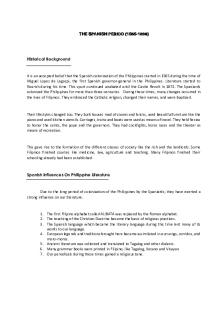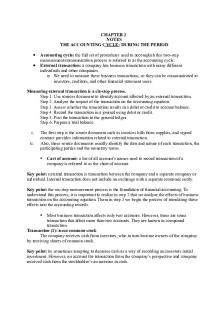The Bustle Period and the Nineties PDF

| Title | The Bustle Period and the Nineties |
|---|---|
| Course | History of Costume |
| Institution | Texas Woman's University |
| Pages | 3 |
| File Size | 90.6 KB |
| File Type | |
| Total Downloads | 35 |
| Total Views | 134 |
Summary
Class lecture on costume during the Bustle Period and the Nineties. Teacher's name: Mrs. Remy Odukomaiya. ...
Description
The Bustle Period and the Nineties: 1870-1900 Historical Background: 1870-1890 Queen Victoria: Prosperity and growth French Peace United America: End of civil war, united nation, no more confederate, considered one entity. Slave trade abolished. 1890-1900 English Moral Drift: Queen Victoria dies 1901, nephew, prince of wales, next to throne. His behavior indicates what year would be. Ladies’ man, Partier, visited Paris a lot, pleasure capital of world. French Pleasure Social Life:1870-1900 Family Oriented: Men of house, Christian family’s. Women employment Women in sports: Tennis, golf, roller skating, bicycling Textile Tech. Processes to improve finish of fabrics Weighting: process that gives more body to silk. Mercerizing: Use for cottons and natural fibers. Helps to improve yarn. Ready-to-wear clothing Ebenezer Butterick: Known for Butterick patterns used today* Cutting Technology: Motorized Blade to cut through ten layers of fabric. Increased to 100. Piecework manufacturing: If a garment has a collar, buttons on front, sleeve on hem. Division of labor for all parts. Merchandising of Ready-to-Wear Mail order catalogs Visual Art and Costume: Styling was very eclectic. Vincent Van Gogh (Starry Night) Aesthetic Dress Pre-Raphaelite Movement: Impressionist movement. Took things from medieval period. Aesthetic Movement: Another movement against making mass produced items. Handmade and crafted instead of machine made. (England Knitting machine) Art Nouveau: New art, no root to previous art styles. Sources of Evidence about costume Photography Mail orders Fashion plates Some art, most were not fully reliable because movement. Garments: Museum General Costume Components for Women: 1870-1890: Fullness is moved to back. Features of the Bustle Period Caged Crinoline: Flexible enough for women to be able to sit. Daytime Dress: 1870-1878
During this time, tendency to make 3 piece ensemble, skirt and two different bodices to go w/skirt, sometimes in same material and sometimes in complimentary material. Fabric draped at back Short Basques: Ext. of bodice from waist down High Necklines Low necklines w/chemisette: modesty piece Close fitted sleeves Matching skirts and bodices Evening Dress:1870-78 Same shape is maintained Highly ornamented bodices: pleats, ribbon, embroidery Off-shoulder sleeves Low Neckline Daytime and Evening dresses: 1878-1883 Reduced Fullness: Smooth waist Asymmetrical designs Long Trains Tied knees: band at back of skirt, ties (cinched in) around knee/knee level (ribbon). Daytime Dress:1883-1890 Table-like bustles: Really exaggerated protrusion at back Short Basques Polonaise: (modest tied or pulled back) High Collars Fitted Sleeves Evening Dress: 1883-1890 Increased trimmings Short sleeves Outdoor Garment: 1870-1890 Ulster Dolman: Sleeve looks like cape but it’s a coat Clothing for active sports Knickers Variations of bloomers suit: full skirts at knee length w/ pants underneath Hair and Headdress Parted hair Ringlets and bangs Footwear Boots: Congress style boots Ball slippers: Used for evenings, for formal outings (typically in velvet) House slippers: ;like mules (backless) Accessories Jewelry Earrings Not many neckline jewelry b/c of high collar. If you did have jewelry it was for a low neckline for events Cosmetics and grooming
Natural/Bland/Washed out. 1870-1900 Camisoles Combination suit Women’s petty coat Corsets for infants, kids and women during 1893 Highly ornamented hats Ridicules (Bag) Women: 1890-1900 Garments Camisoles Shirtwaist or waist: Blouse that stops at the waist Tailor-mades: You got a matching bodice to a skirt, similar to ditto suit (men). Clothing for active sports Bloomer styles Men Birches were not used, 3 piece ensemble Garments Union suits: union suit is to men’s as combination to women. (similar to women’s combination suit) Norfolk jacket Outdoor Garments Inverness cape Ulster (Berg Fashion Library) Children Girls Back to innocence Tunics with wide belts Boys Influences from aesthetic dress Lord Faunt Leroy suits: Knicker boockers (pants) wide sashes, wide lace collars, tight collars, Jackets usually fall below waist. Mourning Costume 1850-1900 Mourning Crape: Woven surface texture, sometimes silk woven in (Jewelry) *One part- outer garments and sleeves of period Images (general) One or two written parts Ex: What is the influence of mass production in time period One bonus*...
Similar Free PDFs

The Reformation Period
- 2 Pages

The Old English Period
- 6 Pages

The Realist Period
- 3 Pages

Astronomy IN THE Abbasid Period
- 2 Pages

The Period of a Pendulum
- 3 Pages

THE VICTORIAN AGE (whole period)
- 27 Pages

Philit during the spanish period
- 6 Pages
Popular Institutions
- Tinajero National High School - Annex
- Politeknik Caltex Riau
- Yokohama City University
- SGT University
- University of Al-Qadisiyah
- Divine Word College of Vigan
- Techniek College Rotterdam
- Universidade de Santiago
- Universiti Teknologi MARA Cawangan Johor Kampus Pasir Gudang
- Poltekkes Kemenkes Yogyakarta
- Baguio City National High School
- Colegio san marcos
- preparatoria uno
- Centro de Bachillerato Tecnológico Industrial y de Servicios No. 107
- Dalian Maritime University
- Quang Trung Secondary School
- Colegio Tecnológico en Informática
- Corporación Regional de Educación Superior
- Grupo CEDVA
- Dar Al Uloom University
- Centro de Estudios Preuniversitarios de la Universidad Nacional de Ingeniería
- 上智大学
- Aakash International School, Nuna Majara
- San Felipe Neri Catholic School
- Kang Chiao International School - New Taipei City
- Misamis Occidental National High School
- Institución Educativa Escuela Normal Juan Ladrilleros
- Kolehiyo ng Pantukan
- Batanes State College
- Instituto Continental
- Sekolah Menengah Kejuruan Kesehatan Kaltara (Tarakan)
- Colegio de La Inmaculada Concepcion - Cebu








